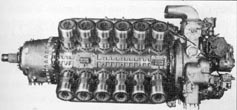
The Armstrong Siddeley Leopard was a British 14-cylinder twin-row air-cooled radial aero engine developed in 1927 by Armstrong Siddeley. It was the most powerful radial engine in the world when introduced.
Rearwin Airplanes was a series of US airplane-manufacturing businesses founded by Andrew ("Rae") Rearwin in 1928. Rae Rearwin was an American businessman who had developed several successful business ventures in the Salina, Kansas area in the early 20th century. Although he had no experience with aircraft manufacturing, he felt that he could succeed with his solid business acumen. With his two sons, Ken and Royce, he hired some engineers and built the Ken-Royce in a garage in Salina. The business moved to the Fairfax Airport in Kansas City, Kansas, and went through several variations before it was sold to Commonwealth Aircraft in 1942, which went bankrupt in 1946.

The Alvis Leonides Major is a British air-cooled 14-cylinder radial aero engine developed by Alvis from the earlier nine-cylinder Leonides.

The Aeronca L was a 1930s American cabin monoplane designed and built, in small numbers, by Aeronca Aircraft. It differed significantly from other Aeronca planes by the use of radial engines, streamlining, and a cantilever low wing.
The Warner Scarab Junior was an American, five-cylinder, air-cooled, radial aero engine first produced in 1930. It was a scaled-down derivative of the seven-cylinder Warner Scarab, developing 90 hp (70 kW) against the Scarab's 110 hp (80 kW).

The Franklin O-200 was an American air-cooled aircraft engine of the early 1940s. The engine was of four-cylinder, horizontally-opposed layout and displaced 200 cu in (3 L). The power output ranged between 65 hp (48 kW) and 100 hp (75 kW) depending on variant. The O-200-5 (4ACG-199) featured a geared propeller drive.

The Rolls-Royce Pennine was a British 46-litre air-cooled sleeve valve engine with 24 cylinders arranged in an X formation. It was an enlarged version of the 22-litre Exe; a prototype engine was built and tested, but never flew. The project was terminated in 1945, being superseded by the jet engine.

The Lawrance J-1 was an engine developed by Charles Lanier Lawrance and used in American aircraft in the early 1920s. It was a nine-cylinder, air-cooled radial design.

The Rolls-Royce Exe, or Boreas, was a 24-cylinder air-cooled X block sleeve valve aircraft engine intended primarily for the new Fairey Fleet Air Arm aircraft, particularly the Fairey Barracuda. The Exe was relatively powerful for its era, producing about 1,100 hp (820 kW). This is notable given the relatively small 1,300 cubic inches (22 L) displacement, the Merlin requiring 1,600 cubic inches (27 L) for approximately the same power level. The X-24 layout made this quite a compact engine.

The Bellanca 14-7 Junior and its successors were a family of light aircraft manufactured in the United States by Bellanca Aircraft Corporation shortly before World War II. They were followed post-war by the Bellanca 14-13 and its derivatives.

The Kinner B-5 was a popular five cylinder American radial engine for light general and sport aircraft of the 1930s.

The ADC Cirrus is a series of British aero engines manufactured using surplus Renault parts by the Aircraft Disposal Company (ADC) in the 1920s.

The Rearwin Sportster is a 1930s American two-seat, high-winged, cabin monoplane designed and built by Rearwin Aircraft & Engines for sport/touring use.

The Rearwin Cloudster was a two or three-seat civil utility aircraft produced by the Rearwin Aircraft & Engines Company of Kansas City, Missouri beginning in 1939. It was a strut-braced, high-wing monoplane of conventional design with an enclosed cabin and fixed, taildragger undercarriage. One specialized version was produced as a trainer for Pan American Airways.
The Rolls-Royce Eagle XVI was a British experimental 16 cylinder aero engine designed and developed by Rolls-Royce Limited in 1925. The engine was test run but did not fly, the project, together with the planned larger variant, the Eagle XX, was cancelled in favour of the Rolls-Royce Kestrel, that was being developed concurrently.

LeBlond Aircraft Engine Corporation was a small engine manufacturer incorporated on April 11, 1928. It was located on the northwest corner of Madison and Edwards Roads in Norwood, Ohio It was a subsidiary of the R. K. LeBlond Machine Tool Company in Cincinnati, Ohio, a manufacturer of metal machining lathes.

The Walter Polaris was a Czechoslovakian three-cylinder, air-cooled radial engine for powering light aircraft that was developed in the 1930s.

The Walter Mars was a Czechoslovakian 14-cylinder, air-cooled radial engine for powering aircraft, a licensed built Gnome-Rhône 14M.

The Rearwin Ken-Royce was an American three-seat sport/touring biplane built by Rearwin Airplanes first in Salina, Kansas then Kansas City. It was the first airplane built by the company.
















